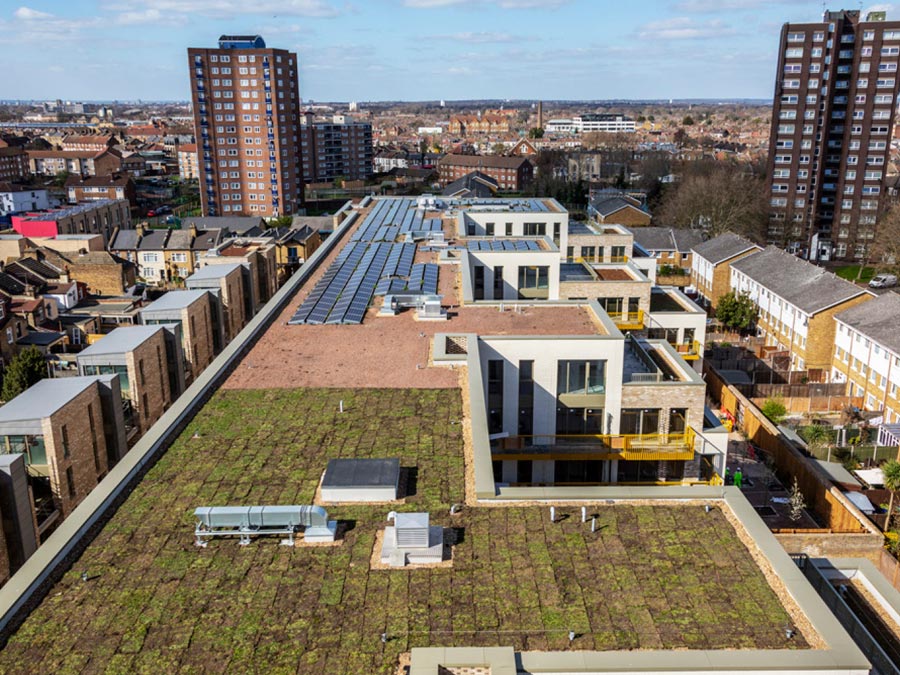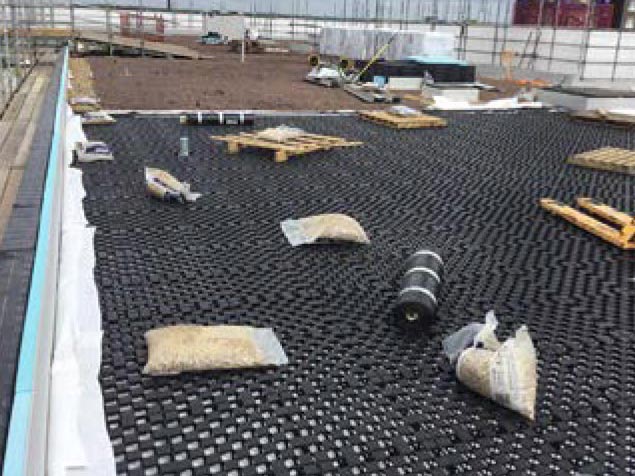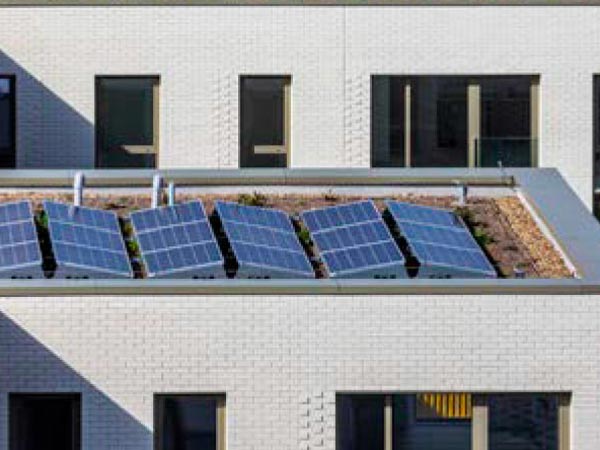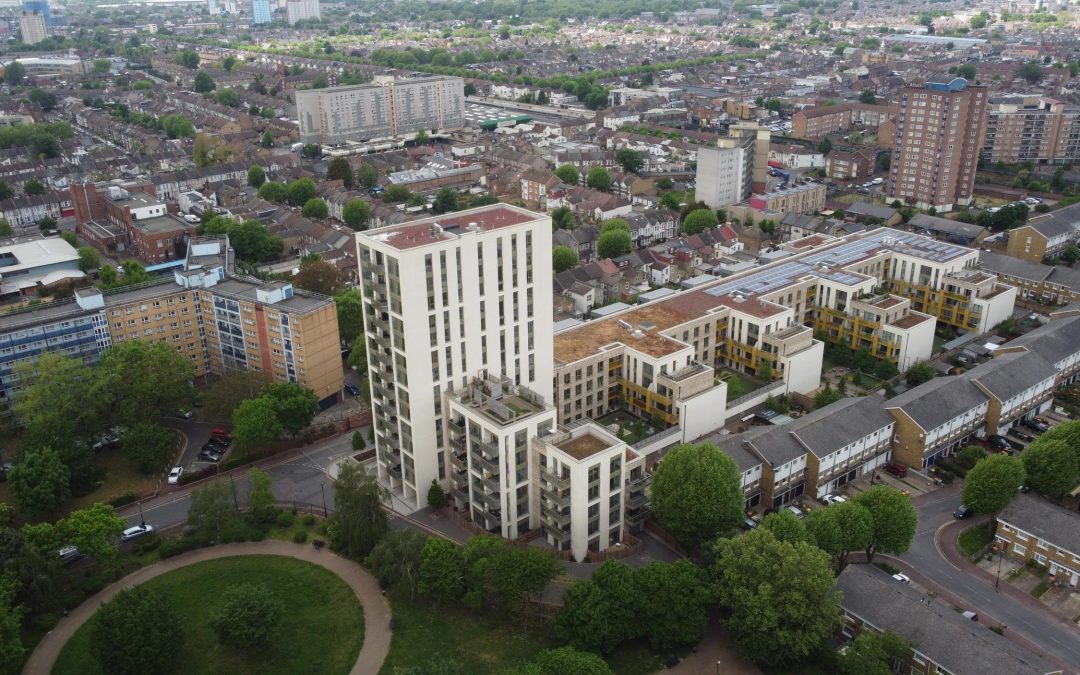This award winning housing development benefits from a combination of green and blue roof systems. Together, the systems provide habitat, rainwater attenuation, amenity areas and superb thermal standards. Read on to discover how the developers, architects and GRO members Radmat collaborated to create attractive, climate friendly living space for an East London community.
The Brief
The Forge has been developed on the site of a former bus depot. It is bounded on two sides by existing residential developments and consists of 192 dwellings. The eclectic mix of apartments and townhouses is clustered around communal courtyards. Each home has its own private outdoor area. Additionally, there is a 6th floor communal roof terrace.
Developers Telford Homes engaged RM_A Architects and Radmat to design buildings with a roofing system that would meet stringent planning requirements from Newham Council.
The blue and green roofs for this development needed to supply numerous benefits to residents, the environment and wildlife.
- Water attenuation – this area of East London is relatively close to the Thames and surface drainage water from the development could contribute to flooding in extreme weather conditions
- High thermal performance with maximum insulation value in order to reduce energy use from heating and air conditioning.
- Support PV panels to maximise energy efficiency.
- Amenity space for residents.
- Visually attractive – particularly where the roofs are overlooked.
- Habitat creation with particular attention to bees, butterflies and birds.

Newly installed vegetation mats bring life to the rooftops of The Forge
The Challenges
This area is geographically somewhat restricted. It is surrounded by existing homes and close to major highways. This means that there is limited space below ground to house SuDS and water attenuation systems.
Newham Council imposed strict planning restrictions on the site in order to protect local residents from being, shaded or overlooked. Quite rightly, there was also strong demand for biodiversity net gain on a site with little room for ground level gardens.
The Solutions
Rainwater Attenuation
Top on the list of priorities for this development was a stormwater management system that could cope with for a 1 in 100 year rainfall event plus allowance for climate change. Below ground water attenuation systems were restricted because of the building’s location. And so Radmat’s design team was challenged to help design a blue roof system that would meet the Council’s requirements.
Radmat’s services include scheme evaluation by in-house architects, bespoke CAD drawings, blue roof calculations and product specification and sourcing. After several adjustments to the design, they specified a blue roof storage reservoirs which sit beneath a standard green roof buildup. The reservoirs are designed to store excess rainwater and allow controlled release into the local sewerage systems once an extreme weather event has passed. This mitigates pressure on drainage systems and reduces the risk of flooding.

Thermal Performance
With so much being asked of the buildings’ roof space, there was a risk of the overall buildup being too deep for the designed parapets. Once again, GRO members, Radmat came up with an innovative solution.
The thermal performance of any building is important and although the living part of a green roof cannot be assigned a U-value, the underlying roof build up can. Radmat recommended ProTherm QuantumVacuum Insulated panels which need 80% less space compared to standard insulants. As an added bonus they are manufactured here in the UK.
Watch this video from GRO members RAVAGO to learn more about the insulation panels used in this project.
PV Panels
PV panels perform better at lower temperatures. The cooling effects of a living roof will help to maximise energy generated by the panels installed atop The Forge.

Amenity Space
Communal roof gardens have been incorporated into the building on the first and 6th floors of this development. These comprise beautiful planting, trees and hard landscaping elements to create a sense of wellbeing and inclusion.
Roofs that are overlooked, but not accessible to the public, are planted with wildflowers to give an interesting aesthetic whilst supporting wildlife. Research suggests that being able to see green space is beneficial to mental and physical health. And so although these roofs are not technically amenity space, they do benefit the inhabitants of The Forge.
Habitat Creation
Radmat recommended installing green roofs that support a variety of planting styles. The intensive green roofs in amenity areas host ‘garden’ type planting which will require moderately frequent maintenance.
For the larger expanses of roof, both sedum and wildflower green roofs have been created. Sedums are low growing, drought tolerant and flower beautifully throughout the spring, summer and autumn months, thus offering forage for pollinating insects.
Wildflowers are being cultivated around the PV panels. The species chosen will tolerate the shaded conditions beneath the panels and also create habitat for a wide range of creatures.
Throughout the complex, carefully formulated substrates have been used as growing media. These will support different flora and provide diverse ecological benefits.
To Summarise
This project deservedly won the AJ Specification Awards in 2020. The work that has gone into designing, specifying and building the blue and green roof systems was completely bespoke to the development and has undoubtedly made an enormous contribution to the sustainability of the area. Mark Harris of Radmat was particularly instrumental in giving the architects’ design team a good insight into value of the GRO Code Of Best Practice. The Forge is testament to the successful collaboration of planners, developers, architects and green roof specialists involved in its creation and should be viewed as a prime example of practical modern architecture.

